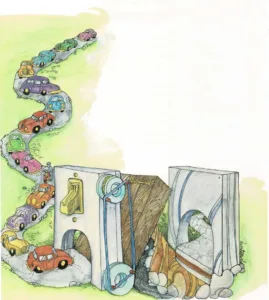
Starting and stopping the push
You want your electric clock to run day and night. But you wouldn’t want
your doorbell ringing all the time! Things like doorbells, lamps, and
radios work only when you turn them on.
Most things that run by electricity have a switch—a part that is used
to turn the electric current on and off. The electric current moves
along the wire and across the switch to another wire inside the bell,
lamp, or radio. The switch is a \”bridge” in the path the electricity
follows.

Inside the switch is a metal piece that moves when you turn the switch
on and off. When you turn the switch on, the metal piece touches
both wires. The \”bridge” is down. The electricity coming into the
switch can cross the \”bridge” and keep traveling along the pathway.But when you turn the switch off, the metal piece moves away from
the wire. The \”bridge” is up. Without the \”bridge,” the electric
current can’t cross the switch and follow the path. So, the electric
current stops moving, and things stop working until you lower the
\”bridge” in the pathway by turning the switch on again.

